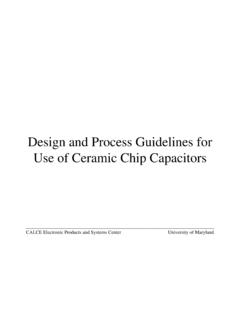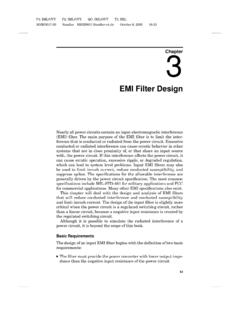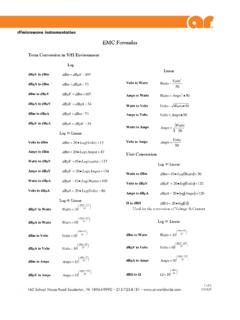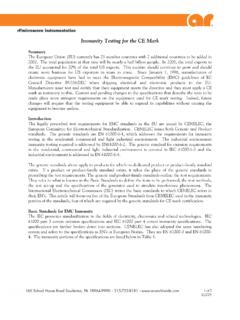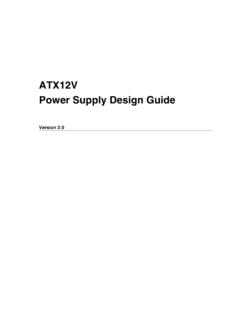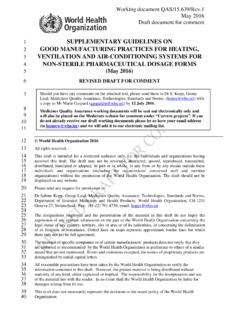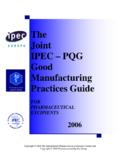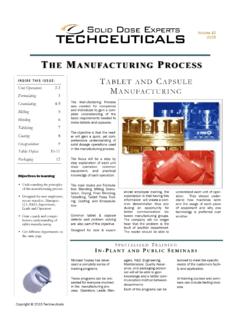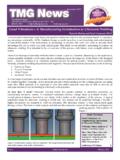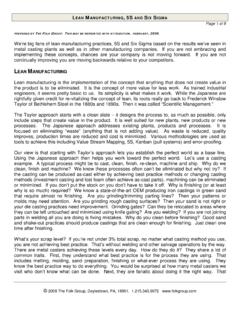Transcription of Laminate & Prepreg Manufacturing - Reverse …
1 & FocuspInternal contamination Reduction - Controlled environment, Treating technology, handling and lay up Consistency - Resin content control, On Line cure monitoring, Redundancy with FTIR, Melt viscosity and GelationpSurface quality - Lay up TechnologypControlled thickness .pCostpProductivity enhancement through lean Manufacturing , Re engineered ProcessespQTApFast turn around capability through cycle time reduction, sophisticated scheduling and equipment capabilityManufacturing Technology FocusB-stage for Laminatefor PWBL aminationpTreatingpGamma Gauges for Resin content controlpOn line DCM s, MMV s, FTIR s pHigh Shear mixing equipment, Dedicated lines, Filtration systemspLay uppSandwich copper concept, separate Clean room environment with Humidity and static temperature pressing capabilitypFinishingpHigh Speed and precise finishing Building BlocksGlass Glass fabric is available in different roll widths and thicknesses Some glass fabrics are different between North America.
2 Asia Pacific and Europe Core constructions are different depending on the region and OEM The resin is determined by what properties are needed to makea particular MLB design function. ie. Tg, Dk, Df etc. The resin must be compatible with the glass fabric The resin must be compatible with the copper foil Copper Copper is designated by wt and foil type Reverse Treat ( RTF ), HTE, Double Treat or std ED copper foil The copper used must be able to achieve good peel strengths so the copper does not pull away from the glass and OEM designs are calling out the number of plies of glass to be usedper core layer and even calling out the glass fabric style when controlled impedance is critical. It is important that we understand the effect of the glass used in theconstruction of the core material we give to an OEM. A 2 ply constructionvs. 1 ply will give you a different Dk and Df based on the retained resin %of the core.
3 When programs move from one Region to the other please be aware of theconstructions used in the other Regions. For critical OEM s and designs weneed to try and keep the electrical properties of the material the same ie the same construction of core material On the next slide you will see the different glass styles used in North AmericaAsia Pacific and Glass FabricGlassWeaveWarpFill Warp Fill FabricFabricFabricFabricStyleCountCountY arnYarnThicknessThicknessNominal WeightNominal WeightinchesmmOSYg/m21067 Plain7070 ECD 900-1/0 ECD 900-1 900-1/0 ECD 900-1 450 1/0 ECD 450 1 450-1/0 ECD 450-1 225-1/0 ECD 450-1 225- 1/0 ECD 450-1 300-1/0 ECDE 300-1 300-1/0 ECDE 300-1 225-1/0 ECE 225-1 110-1 150-1/0 ECG 150-1 75-1/0 ECG 75-1 Yarn Nomenclature1st LetterE = E-glass ( electrical grade )
4 2nd LetterC = Continuous Filaments3rd LetterFilament Diameter D, E, DE, GIst numberYardage in one pound 2nd numberNumber of strands in a yarn/ strands plied or Glass Fabric106 Warp & Fill Count:56 x 56 (ends/in) / mm1080 Warp & Fill Count: 60 x 47 (ends/in)Thickness: / mmPhotos courtesy of Isola R & D Laboratories Glass Fabric1067 Warp & Fill Count:70 x 70 (ends/in) / mm1086 Warp & Fill Count: 60 x 60 (ends/in)Thickness: / mmPhotos courtesy of Isola R & D Laboratories & Fill Count: 60 x 56 (ends/in) / mmWoven Glass FabricPhotos courtesy of Isola R & D Laboratories 2313 Warp & Fill Count: 60 x 64 (ends/in) / & Fill Count:70 x 70 (ends/in) / mmWoven Glass Fabric3313 Warp & Fill Count:61 x 62 (ends/in) / mm3313 50 x3070 50 xPhotos courtesy of Isola R & D Laboratories & Fill Count:60 x 58 (ends/in) / mmWoven Glass FabricPhotos courtesy of Isola R & D Laboratories 1652 Warp & Fill Count:52 x 52 (ends/in) / & Fill Count:44 x 32 (ends/in) / mmWoven Glass FabricPhotos courtesy of Isola R & D Laboratories 1506 Warp & Fill Count:46 x 45 (ends/in) / America106108010671086211333133070211616 527628 Asia-Pacific1061035107810801067108623133 313 211615011506 16527628 Europe1061080211330702116163416471651150 1216521577628 Isola has Global Std Constructions on the High Performance Materials Regional Woven Glass Fabric plateCopper2 pliesB-StageCopperSep.
5 PlateMultilayer Core Resin %1 x 1652 42 %106 / 2113 54 %2 x 1080 56 %1 x 2116 54 %PositivesCost/ Thickness/ DSDS/ Std 2 plyLow CostLow CostNegativesLow Resin/ thick glassMost ExpensiveDS/ ThicknessDS/ ThicknessTypical IS415 Core ConstructionsDk / Df differences based on retained resin %. The difference can be up to 14 %At 2 GHz Dk on 42 % = Df on 42 % = 2 GHz Dk on 56 % = Df on 56 % = that the right core thickness is used by the OEM/ Designer to meet the impedance Direction 50 wide glass 50 x 38 untrimmed 48 x 36 trimmed oversized panelsavailable24 18 18 24 50 wide Glass - Fill DirectionGrain Directionor Warp Copper Foil Manufacturing Copper is electroplated onto a rotating drum. Treatments are applied to: Micro-roughen surface for adhesion Plate barrier layer Coat with wt18 micron = H oz 35 micron = 1 oz70 micron = 2 ozHeavier copper suchas 3, 4 and 5 oz foil used for power supply designs or ground planes in MLB designs5 and 6 oz Cu forAutomotive 4 L designs12 oz Cu used for Automotive 2 L designsCopper Foil TypesED= standard shiny copper, copper toothHTE= High temp elongation shiny copper, copper toothRTF= Reverse treat, low profile copper toothDT= double treat copper, no black oxide needed The RTF copper foils offer benefits to the fabricator during processing more defined etched line, ability for thinner lines and lower copper tooth profile.
6 VLP foils are used for better impedance control 95+ % of NA is RTF foil. Very small percentage = DT Thicker cores still use some HTE or ED Copper Foil ED Foil is Industry Standard Many thicknesses available , 1 and 2 ounce the most common 3+ available 9, 5, 3 micronGrade Foil Description 1 Standard Electrodeposited 2 High Ductility Electrodeposited 3 High Temperature Elongation Electrodeposited 4 Annealed Electrodeposited 5 As Rolled-Wrought 6 Light Cold Rolled-Wrought 7 Annealed-Wrought 8 As Rolled-Wrought Low-Temperature Annealable Foil Designator Common Industry Terminology Area Weight (g/m2) Nominal Thickness ( m) Area Weight (oz/ft2) Area Weight (g/254 in2)
7 Nominal Thickness (mils) E 5 m Q 9 m T 12 m H oz M oz 1 1 oz 1 2 2 oz 2 3 3 oz 3
8 4 4 oz 4 5 5 oz 5 6 6 oz 6 7 7 oz 7 10 10 oz 10 14 14 oz 14 Foil Profile Type Max.
9 Foil Profile (Microns) Max. Foil Profile ( Inches) S Standard N/A N/A L Low Profile 400 V Very Low Profile 200 X No Treatment or Roughness N/A N/A Surface Profiles Matte Side Surface ProfileMatte Side of Standard Grade 1 FoilMatte Side of Low Profile Grade 1 FoilLaminateWith StandardCopperFoilLaminateWith DSTFoil CopperFoil Standard vs Drum Side Treated Foil ( DSTFoil ) Process Comparison to Standard Copper FoilComparison to Standard Copper FoilDSTFoil Standard CopperDSTF Process Foil Clad LaminateStandard Foil Clad LaminateDSTF Process IntroductionDSTFoil DSTFoil Clad LaminateClad Electromagnetic Spectrum employed for RF & Microwave applicationsShortwave radioMobile Radio3 MHz10 MHz30 M30 MHzVHF TV BeginsFM Broadcast Radio100 MHz3 MHFVHFM obile RadioRFVHF TV Begins300 MHzUHF TV endsCellular phone1 GHz30 cmGPSPCS3 GHzBluetoothWireless LANUHFMWMMW10 GHz3 cm30 GHzDBSR emote Glass Transition Temperature; The temperature at which the resin changes from a glass-like state to an amorphous state changing its mechanical behavior, expansion rate DSC Differential Scanning Calorimetry.
10 A measurement technique used to characterize the glass transition temperature of a resin by measuring the change in heat given off the resin. TMA Thermal Mechanical Analysis; A measurement technique used to characterize the glass transition temperature of a resin by measuring the changing in thermal expansion of a resin as a function of temperature. DMA Dynamic Mechanical Testing; A measurement technique used to characterize the glass transition temperature of a resin by measuring the change in modulus of a resin as a function of temperature. TD Decomposition Temperature; The temperature at which the resin begins to decompose, measured by a weight change the resin sample. Thermo-Gravimetric Analysis; A measurement technique used to characterize the decomposition temperature of a resin by measuring the change in weight as a function of temperature.
